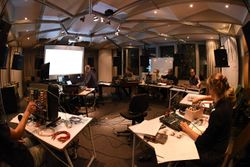Electronic studio: Difference between revisions
No edit summary |
No edit summary |
||
| (103 intermediate revisions by 5 users not shown) | |||
| Line 1: | Line 1: | ||
= | = About = | ||
[[File:EOC Proben 2018.jpg|250px]] | |||
The electronic studio of [https://www.tu-berlin.de TU Berlin] (part of [https://www.ak.tu-berlin.de/ audio communication group]) consists of the two studio rooms [[EN324]] (aka ''large studio'') and [[EN325]] (aka ''small studio'') and their shared engineering room [[EN326]]. | |||
This wiki is meant to help and assist you working with the hardware available in the electronic studio. | |||
If you have a problem, try the [[#Help| Help]] section below. | |||
The studio team always tries to improve the content, so if you have any remarks about things you'd like to see in here, [mailto:studio@ak.tu-berlin.de let us know]! | |||
[ | The electronic studio at TU Berlin is not a typical sound studio. It was designed as a research facility and experimental studio, thus differs in many ways from a conventional commercial music production studio. | ||
Although different multi-channel setups and very complex routings are possible, you'll also find straight-forward and standard compliant studio gear or software. | |||
Additional information regarding the studio's [https://github.com/audiocommunication/studio-documentation documentation can be found on github]. | |||
= Instructions = | |||
The following links contain instructions | |||
for starting specific setups in the studios. | |||
[[Starting the Ambisonics Renderer]] | |||
= | = Manuals = | ||
The following pages are meant to guide your workflow in the electronic studio. We hope they will be helpful! | |||
[ | [[EN324]] | ||
[ | [[EN325]] | ||
[mailto: | [[EN326]] | ||
[[EN327]] | |||
[[EN328]] | |||
[[Wiring Diagrams]] | |||
= Machines = | |||
[[ Trevor ]] | |||
[[ Taunus ]] | |||
[[ Wintermute ]] | |||
[[ SPRAWL ]] | |||
= IP Addresses = | |||
'''Eduroam''' | |||
Trevor: 130.149.23.47 | |||
Taunus: 130.149.23.46 | |||
Matrix_325: 130.149.23.49 | |||
'''WFS''' | |||
= Contact = | |||
Please send all requests regarding the electronic studio to [mailto:studio@ak.tu-berlin.de studio@ak.tu-berlin.de]. | |||
= Staff = | |||
[http://www.ak.tu-berlin.de/menue/team/wissenschaftliche_mitarbeiter/henrik_von_coler| Henrik von Coler], Studio manager | |||
Nils Tonnätt, Studio Assistant | |||
[http://www.ak.tu-berlin.de/menue/team/studentische_mitarbeiter/paul_schuladen| Paul Schuladen], Studio tutor | |||
[https://www.ak.tu-berlin.de/menue/team/it_administration/marc_voigt| Marc Voigt], IT administrator | |||
= Help = | |||
Due to the high amount of technical possibilities at the electronic studio and the various users (and their differing needs) it is possible to run into problems with the hardware or software (or both). | |||
Most issues arise because of improper use or reset of the studio hardware, or buggy software. | |||
On the separate [[Help]] page you can find help for some of the known problems, that you might run into, when using the studio. | |||
<span style="background:#FF6347">'''Attention:''' By using the electronic studio, you inherently agree to the [[Terms of Use]]!</span> | |||
Latest revision as of 15:42, 23 October 2019
About
The electronic studio of TU Berlin (part of audio communication group) consists of the two studio rooms EN324 (aka large studio) and EN325 (aka small studio) and their shared engineering room EN326.
This wiki is meant to help and assist you working with the hardware available in the electronic studio.
If you have a problem, try the Help section below.
The studio team always tries to improve the content, so if you have any remarks about things you'd like to see in here, let us know!
The electronic studio at TU Berlin is not a typical sound studio. It was designed as a research facility and experimental studio, thus differs in many ways from a conventional commercial music production studio. Although different multi-channel setups and very complex routings are possible, you'll also find straight-forward and standard compliant studio gear or software. Additional information regarding the studio's documentation can be found on github.
Instructions
The following links contain instructions for starting specific setups in the studios.
Starting the Ambisonics Renderer
Manuals
The following pages are meant to guide your workflow in the electronic studio. We hope they will be helpful!
Machines
IP Addresses
Eduroam
Trevor: 130.149.23.47
Taunus: 130.149.23.46
Matrix_325: 130.149.23.49
WFS
Contact
Please send all requests regarding the electronic studio to studio@ak.tu-berlin.de.
Staff
Henrik von Coler, Studio manager
Nils Tonnätt, Studio Assistant
Paul Schuladen, Studio tutor
Marc Voigt, IT administrator
Help
Due to the high amount of technical possibilities at the electronic studio and the various users (and their differing needs) it is possible to run into problems with the hardware or software (or both).
Most issues arise because of improper use or reset of the studio hardware, or buggy software.
On the separate Help page you can find help for some of the known problems, that you might run into, when using the studio.
Attention: By using the electronic studio, you inherently agree to the Terms of Use!
